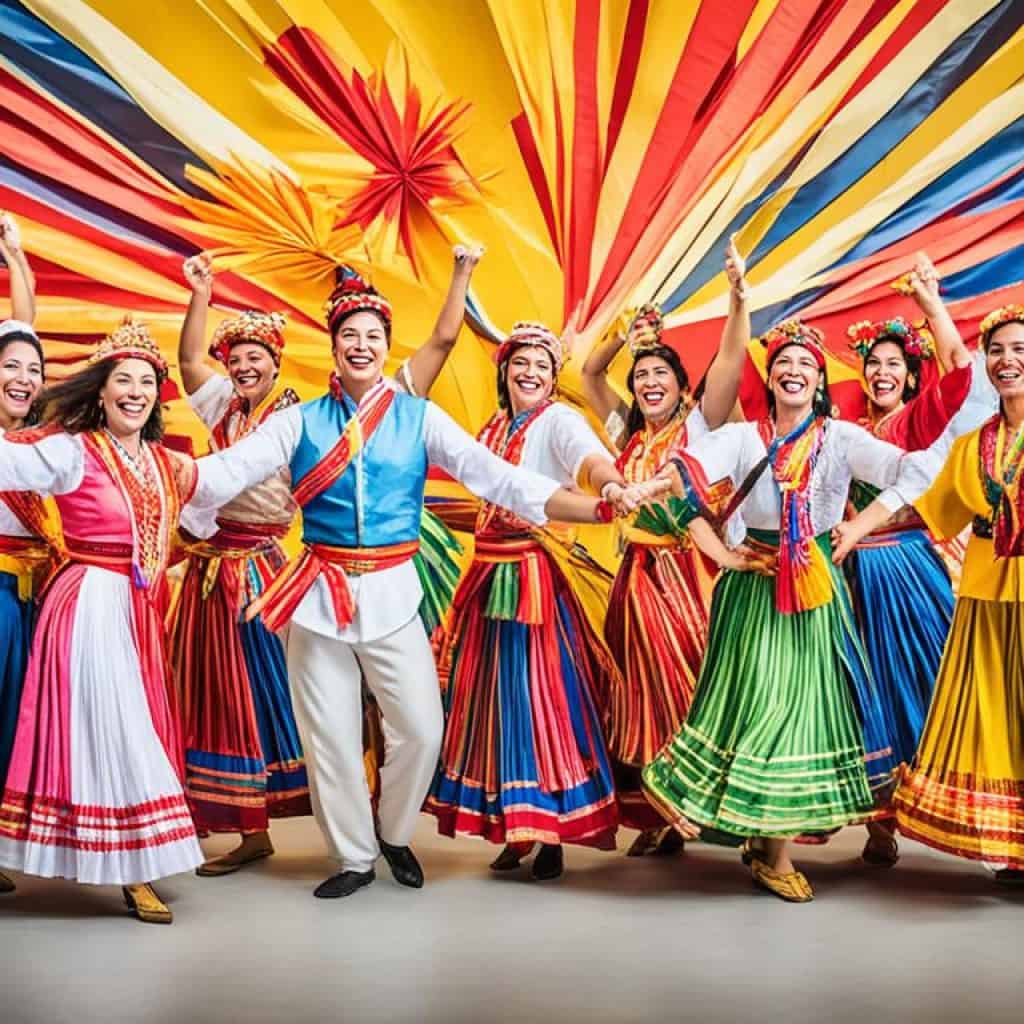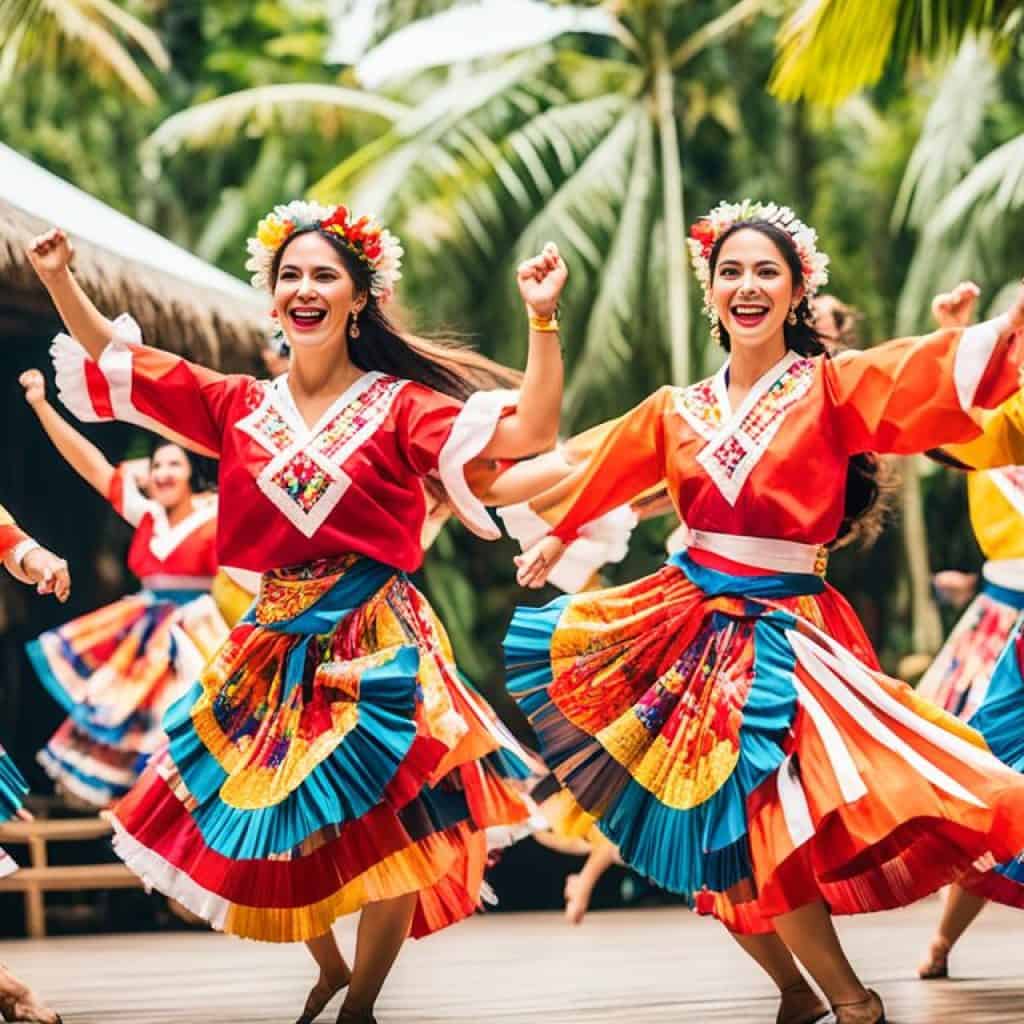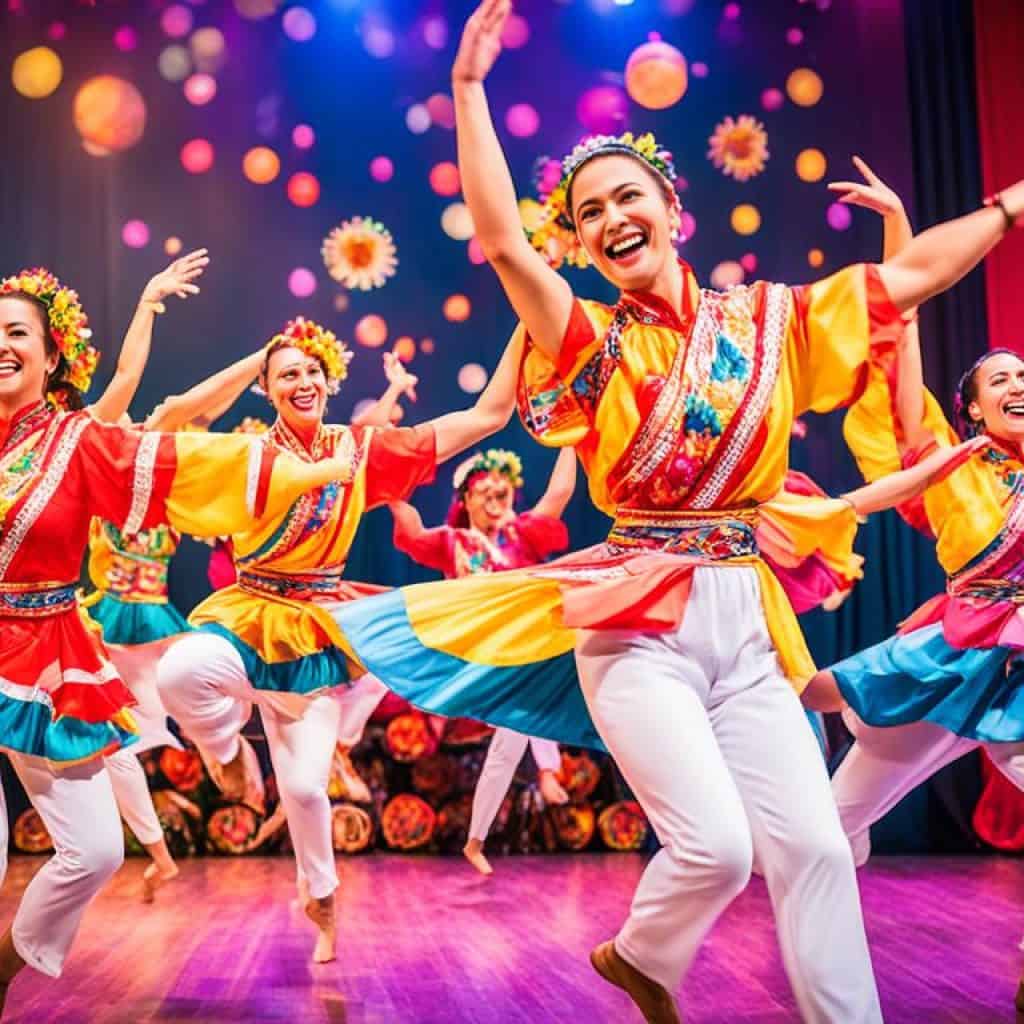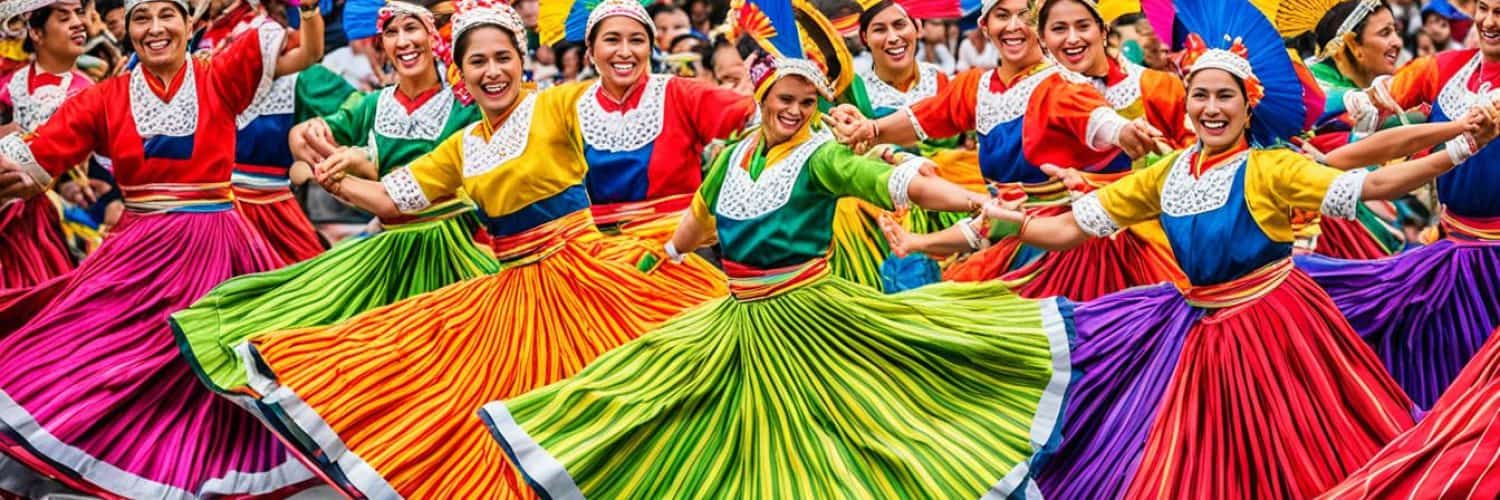Have you ever wondered what makes Philippine folk dances so unique and captivating? From the graceful movements of the Tinikling to the vibrant rhythms of the Maglalatik, these traditional dances hold a significant place in the country’s cultural heritage. But what exactly is folk dance in the Philippines? Let’s dive deeper into this rich and colorful artistic tradition and uncover the stories behind these mesmerizing performances.
Key Takeaways:
- Philippine folk dances are an integral part of the country’s cultural heritage.
- These dances showcase the diversity and richness of Filipino traditions.
- Folk dances in the Philippines have been influenced by various cultures throughout history.
- They play a crucial role in promoting cultural diversity and fostering intercultural dialogue.
- Preserving and promoting Philippine folk dances is vital for cultural preservation and education.
Cultural Heritage Value of Philippine Folk Dances
Philippine Folkdance is a treasure trove of intangible cultural heritage that showcases the country’s cultural diversity and indigenous dances. These folk dances hold immense cultural and historical significance, serving as a testament to the rich heritage of the Philippines.
Preserving and promoting these cultural dance forms is crucial in fostering cultural diversity and ensuring the sustainability of intangible heritage. Through festivals, educational programs, and community initiatives, the value of Philippine Folk Dances is continuously reinforced.
“Philippine Folk Dances are a living tradition that links the past, present, and future generations, allowing us to embrace our cultural roots and appreciate the diverse dance forms that have been passed down through generations.”
The indigenous dances encapsulate the unique traditions, rituals, and narratives of the various regions in the Philippines. These dances are not just a form of entertainment; they serve as a powerful medium for cultural expression, storytelling, and social cohesion.
By promoting the cultural heritage value of Philippine Folk Dances, we deepen our understanding of the nation’s identity and foster intercultural dialogue. These dances strengthen the bond among communities and bring people together in celebration of their shared heritage.
The Significance of Cultural Dance Forms
The cultural dance forms represent the distinct artistic expressions and beliefs of each region within the Philippines. They reflect the historical, social, and spiritual aspects of the indigenous communities, highlighting their love for music, movement, and creativity.
Indigenous dances serve as a bridge between the past and the present, carrying the stories, traditions, and wisdom of the ancestors. They remind us of the importance of cultural preservation and the need to honor the unique cultural tapestry that defines the Philippines.
| Dance Form | Origin | Characteristics |
|---|---|---|
| Tinikling | Visayas | A dance that involves skillfully maneuvering between bamboo poles |
| Singkil | Mindanao | A royal dance that tells the epic legend of Princess Gandingan |
| Pandanggo sa Ilaw | Luzon | A dance performed with lighted oil lamps |
These dance forms serve as windows into the diverse cultures and traditions prevalent across the Philippines’ archipelago. They evoke a sense of pride and belonging among Filipinos and leave a lasting impression on those who experience their beauty and grace.
Through their unique movements, colorful costumes, and vibrant music, Philippine Folk Dances celebrate the heritage, resilience, and spirit of the Filipino people. They are an essential part of the cultural fabric that unites and inspires communities throughout the country.
History and Evolution of Philippine Folk Dance
The rich history of Philippine Folk Dance can be traced back to three significant periods: the pre-colonial period, Muslim influence, and Spanish influence.
During the pre-colonial period, dances were not only a form of entertainment but also held immense cultural and spiritual significance. These dances were performed as rituals and offerings to the gods. They expressed gratitude, sought blessings, and appeased divine powers. The movements were graceful and fluid, reflecting the deep connection between the dancers and their spiritual beliefs.
The arrival of Muslim merchants in the islands introduced a new element to Philippine Folk Dance – storytelling. Muslim-influenced dances became a means of narrating epic tales, legends, and historical events. Through intricate movements and gestures, these dances conveyed captivating stories that were passed down from generation to generation.
The Spanish colonization of the Philippines heavily influenced the evolution of Philippine Folk Dance. The Spanish introduced court choreography, which merged with the existing local dance forms to create a unique fusion. Spanish-influenced dances showcased grace, elegance, and aristocracy, while incorporating indigenous Philippine elements. The fusion of Spanish court choreography and local dance styles resulted in the birth of captivating dances such as “Tinikling,” “Singkil,” “Cariñosa,” and “Pandanggo sa Ilaw.”
Throughout history, the evolution of Philippine Folk Dance reflects the diverse cultural influences that have shaped the country’s identity. The pre-colonial period, Muslim influence, and Spanish influence have all contributed to the rich tapestry of Philippine Folk Dance, making it an integral part of the nation’s heritage.
Evolution of Philippine Folk Dance
| Period | Description |
|---|---|
| Pre-colonial Period | Dances performed as rituals and appeasements to the gods |
| Muslim Influence | Introduction of storytelling dances |
| Spanish Influence | Court choreography merged with local dance forms |
Classification of Folk Dances in Luzon
Folk dances in Luzon are classified into different categories based on their geographic location, origin, and description. These dances showcase the diversity and cultural richness of the region. Let’s explore three significant classifications: Maria Clara Dance, Cordillera Dance, and Rural Dance.
Maria Clara Dance
The Maria Clara dance, originating from Luzon and Visayas, reflects the influence of the Spanish colonial period. This graceful and elegant dance is named after the character Maria Clara in Jose Rizal’s novel, Noli Me Tangere. It traditionally depicts the graceful movements of a Filipina wearing the Maria Clara dress, a traditional attire characterized by its intricate designs and butterfly sleeves.
Cordillera Dance
The Cordillera dances, performed by the ethnic groups in the northern mountains of Luzon, have deep cultural significance. These dances celebrate victories, festivals, and religious rituals. The Cordillera region is known for its strong indigenous culture, and the dances reflect the traditions and stories passed down through generations. The lively and rhythmic movements, accompanied by indigenous music, showcase the vibrant cultural heritage of the Cordillera people.
Rural Dance
Rural dances in Luzon capture the fiesta spirit and the joy of rural life. These dances are performed during festive occasions, such as town fiestas or gatherings in farming communities. The vibrant and energetic movements reflect the love for life and community spirit of the people. The costumes worn during rural dances are colorful and showcase the distinctive traditional attire for both men and women.
Dancing is an integral part of Filipino culture, and folk dances in Luzon play a crucial role in preserving and promoting the country’s heritage. These dances not only reflect historical influences but also showcase the diversity and creativity of the Filipino people.
Folk Dances in Visayas
Visayas, a central group of islands in the Philippines, is home to a rich tapestry of unique folk dances. These dances are a celebration of the region’s culture and traditions, showcasing the creativity and artistry of the Visayan people. Let’s explore some of the most prominent folk dances in Visayas.
Maglalatik
The Maglalatik dance originated in Biñan, Laguna, and has become a significant part of Visayan culture. This dance depicts a mock-war between the Moros and Christians, with the performers showcasing their skill and agility through synchronized movements. The dance incorporates the use of coconut shells, which the dancers rhythmically strike against their bodies, creating captivating music and adding visual flair to the performance.
Sayaw sa Bangko
The Sayaw sa Bangko is a lively and energetic folk dance performed during town fiestas in Visayas. This dance involves a row of dancers gracefully and skillfully moving on a narrow wooden bench, showcasing their balance and coordination. With synchronized steps and vibrant music, the Sayaw sa Bangko captivates the audience and reflects the joyful spirit of the Visayan people.
Subli
Hailing from Bauan, Batangas, the Subli is a ritual dance that holds deep religious significance. It is performed to honor the Holy Cross and is often seen during street processions and religious festivals in Visayas. The dance is characterized by rhythmic movements, expressive gestures, and elaborate costumes, creating a mesmerizing spectacle that pays homage to ancestral traditions and spiritual beliefs.
Tinikling
When it comes to folk dances in Visayas, one cannot overlook the iconic Tinikling. Considered the national dance of the Philippines, Tinikling involves dancers skillfully maneuvering between bamboo poles to the rhythm of the music. This dynamic and graceful dance showcases the agility and coordination of the performers, while also symbolizing resilience and unity. The Tinikling has gained global recognition and is often taught as part of the cultural curriculum in schools.
Visayas’ folk dances, such as Maglalatik, Sayaw sa Bangko, Subli, and Tinikling, represent the vibrant cultural heritage of the region. Through these dances, the Visayan people pay tribute to their history, traditions, and artistic prowess. Whether you witness these dances in a cultural event or join in the rhythmic movements yourself, they offer a unique and captivating experience that will leave you in awe of Visayas’ rich cultural tapestry.
Folk Dances in Mindanao
Mindanao, the southernmost region of the Philippines, is a rich tapestry of diverse ethnic groups, each with their unique folk dances. These captivating dances reflect the region’s cultural heritage and tell stories of love, bravery, and mythical legends. Let’s explore some of the fascinating folk dances from Mindanao:
Asik
Asik is a mesmerizing solo dance performed by a maiden to entice and win the favor of a Sultan. With graceful movements and expressive gestures, the dancer captivates the audience, embodying elegance and allure. Asik showcases the artistry and charm of Mindanao’s cultural traditions.
Kini Kini
Kini Kini is a regal and graceful walk performed by Maranao women, adorned in vibrant traditional attire and delicately holding long, flowing scarves. This dance exudes elegance and poise, as the women glide across the stage, showcasing the beauty and sophistication of Mindanao’s rich cultural heritage.
Pangalay
Pangalay is native to the Badjao people, also known as “Sea Gypsies.” This dance form emphasizes the agility and fluidity of the upper body, with dancers seamlessly moving their arms, hands, and fingers in intricate patterns. The graceful movements of Pangalay depict the harmony between humans and the sea, celebrating the Badjao’s deep connection to their maritime environment.
Singkil
One of the most iconic folk dances in the Philippines, Singkil tells the epic legend of Princess Gandingan, who deftly navigates through a maze of swaying bamboo poles, symbolizing danger and adversity. Dancers glide and leap with precision and grace, captivating the audience with their skillful maneuvers. Singkil showcases the resilience and courage embodied in Philippine folklore.
The folk dances of Mindanao capture the spirit, diversity, and cultural richness of the region’s ethnic groups. Through their captivating movements and storytelling, these dances keep traditions alive and provide a glimpse into the vibrant heritage of the Philippines.
| Folk Dance | Description |
|---|---|
| Asik | A solo dance performed by a maiden to win the favor of a Sultan. |
| Kini Kini | A royal walk performed by Maranao women with scarves, showcasing elegance and poise. |
| Pangalay | A dance emphasizing the agility of the upper body, native to the Badjao or “Sea Gypsies.” |
| Singkil | A legendary dance depicting the epic tale of Princess Gandingan and featuring skilled bamboo pole maneuvers. |
Importance of Folk Dance as Cultural Heritage
Folk dances play a significant role in cultural development and identity, serving as a powerful means of expression and celebration. They go beyond mere movements and steps, representing the very essence of a community’s traditions, beliefs, and values. Through folk dances, individuals connect with their roots, deepening their understanding of their cultural heritage and strengthening their sense of belonging.
One of the remarkable aspects of folk dance is its ability to provide experiential learning. Rather than solely relying on textbooks or lectures, folk dance offers a hands-on approach that engages participants physically, emotionally, and intellectually. By actively participating in the dance, individuals gain insights into the history, customs, and stories embedded within the dance. This immersive experience fosters a deeper appreciation for the cultural significance of folk dances, ensuring their preservation for future generations.
Furthermore, folk dances have the power to promote cultural diversity by showcasing the rich tapestry of human traditions. Each dance reflects the unique nuances, rhythms, and movements influenced by specific regions, ethnicities, and historical contexts. By embracing and celebrating this diversity, folk dances act as bridges that connect different communities and countries, fostering cooperation and intercultural dialogue.
“Folk dances are the living embodiment of cultural heritage, serving as a testament to the resilience and creativity of a community.”
When folk dances are shared and appreciated, they contribute to the broader tapestry of human cultural heritage. They become windows into different ways of life, offering glimpses into the values, attitudes, and aesthetics of the past and present. Through folk dances, we celebrate the stories and experiences of our ancestors, acknowledging their contributions to our present cultural landscape.
| Benefits of Folk Dance as Cultural Heritage |
|---|
| Strengthening Cultural Identity |
| Promoting Cultural Diversity |
| Fostering Cooperation and Intercultural Dialogue |
As we recognize the importance of folk dance as a cultural heritage, it becomes our responsibility to protect and preserve these invaluable art forms. Through education, performances, and cultural initiatives, we can ensure that folk dances continue to thrive, inspiring future generations and fostering a global appreciation for the diversity of human expression.

Folk dance promotes cultural diversity and fosters intercultural dialogue.
Folk Dance and Tourism
Folk dances in the Philippines serve as a valuable tourism resource, allowing visitors to witness and experience the country’s rich cultural heritage firsthand. These vibrant and captivating performances promote the culture and traditions of the Philippines while also contributing to the preservation of its unique folk dances for future generations.
One of the notable events that attract tourists from around the world is the Fiesta Folkloriada, a celebration of folk dances that showcases the diversity and beauty of Philippine culture. This event serves as a platform for local and international dancers to come together and share their passion for traditional dance forms.
Additionally, international folk dance festivals provide opportunities to promote Philippine folk dances on a global scale. These festivals bring together performers and enthusiasts from different countries, fostering cultural exchange and appreciation.
By embracing folk dance as a tourism resource, the Philippines can highlight its cultural richness and promote a deeper understanding and respect for its traditions. This not only benefits the tourism industry but also ensures the preservation and continued practice of the country’s folk dances as a vital part of its intangible cultural heritage.
| Tourism Benefits of Folk Dance | Cultural Promotion | Cultural Preservation |
|---|---|---|
| Attracts tourists | Brings international recognition to Philippine culture | Preserves traditional dances for future generations |
| Creates opportunities for cultural exchange | Fosters appreciation and understanding of different cultures | Maintains the country’s intangible cultural heritage |
| Enhances the tourism industry | Builds bridges between communities and countries | Contributes to the identity and unique character of the Philippines |
“Folk dances serve as a powerful tool for promoting cultural diversity and preserving the rich heritage of the Philippines.” – Lee Tucker, dance instructor
Through the seamless integration of folk dance into tourism initiatives, the Philippines can showcase its vibrant and diverse culture to the world, fostering appreciation and understanding while ensuring the preservation of its cultural traditions for generations to come.
Tinikling – The Most Popular Philippine Folk Dance
Tinikling is a captivating and vibrant folk dance that holds a special place in the hearts of Filipinos. Named after the tikling bird, known for its grace and agility, this dance mimics the bird’s mating ritual, showcasing intricate footwork and rhythmic movements.
As the most popular folk dance in the Philippines, Tinikling has become an integral part of the country’s cultural fabric. It is celebrated for its ability to capture the essence of Philippine heritage and tradition, while also captivating audiences with its energetic and visually stunning performances.
One of the reasons Tinikling has gained widespread popularity is its inclusion in the physical education program for schools. This dance not only promotes physical fitness but also instills cultural pride and appreciation in the younger generation.
Through its incorporation into the curriculum, students have the opportunity to develop coordination, agility, and teamwork, all while connecting with their cultural roots. Tinikling encourages students to engage actively in physical activity, fostering a love for dance and movement that extends beyond the classroom.
The beauty of Tinikling lies in its intricate footwork and the skillful maneuvering between bamboo poles. Dancers gracefully weave through the poles, representing the agility and grace of the tikling bird. This rhythmic dance requires precision and coordination, captivating audiences with its captivating display of talent and artistry.
Instructors like Lee Tucker have played a significant role in preserving and promoting the art of Tinikling. Their passion and dedication have ensured that this iconic dance continues to be taught and performed, passing on the rich cultural heritage of the Philippines to future generations.
“Tinikling is not only a dance; it is a symbol of our identity and heritage. Through this dance, we celebrate the beauty and grace of our culture, leaving a lasting impression on those who witness its mesmerizing performance.”
Benefits of Tinikling in Physical Education Programs:
- Enhances agility and coordination
- Promotes cardiovascular fitness
- Develops teamwork and cooperation
- Boosts confidence and self-expression
- Cultivates cultural awareness and pride
By including Tinikling in the physical education program, schools not only promote physical fitness but also foster an appreciation for the rich cultural heritage of the Philippines. This dance serves as a powerful tool for cultural preservation and connects students with their roots, ensuring that the tradition of Tinikling lives on for generations to come.
Appreciating Asian Pacific American Heritage
In the face of recent acts of hate towards Asians, it is crucial to appreciate and embrace Asian Pacific American heritage. Asian communities, including Filipinos, contribute to the cultural richness of the United States. By celebrating and promoting their heritage, they strengthen their sense of belonging and combat prejudice and discrimination.
Asian Pacific American heritage encompasses a wide range of traditions, customs, languages, and art forms that have shaped American society. From vibrant festivals and culinary traditions to unique styles of dance and music, this heritage reflects the diverse experiences and contributions of Asian Pacific Americans.
Recognizing and appreciating Asian Pacific American heritage not only honors the rich cultural tapestry of the community but also promotes understanding, inclusivity, and respect. It allows individuals from all backgrounds to learn from and engage with the unique perspectives and traditions of Asian Pacific Americans.
Embracing Asian Pacific American heritage is an opportunity to learn, grow, and build bridges of understanding in our increasingly diverse society.
Through initiatives like Asian Pacific American Heritage Month, communities come together to celebrate the history, achievements, and contributions of Asian Pacific Americans. This month-long celebration creates space for storytelling, cultural performances, exhibitions, and educational programs that highlight the heritage’s richness and importance.
Combating Asian Hate through Cultural Appreciation
In light of the rise in Asian hate crimes and discrimination, appreciating Asian Pacific American heritage takes on even greater significance. By showcasing the diversity, beauty, and significance of Asian cultures, we challenge harmful stereotypes and combat the ignorance that drives hate.
Asian Pacific American heritage represents resilience, strength, and overcoming adversity in the face of discrimination and marginalization. It provides a platform for Asian Pacific Americans to reclaim their narratives, share their stories, and gain visibility in a society that all too often overlooks their contributions.
Through education and cultural appreciation, we can dismantle the stereotypes, biases, and prejudices that perpetuate hate. By learning about Asian Pacific American history, traditions, and achievements, we foster empathy, compassion, and solidarity among communities.
Appreciating Asian Pacific American heritage is a call to action that urges us all to stand against hate, discrimination, and xenophobia. Together, we can build a more inclusive society that values and celebrates the rich tapestry of cultures that make America a diverse and vibrant nation.

“When we understand and appreciate the diverse cultures that have shaped our present, we can build a future of unity, equality, and respect for all.”
Occupational Dances in the Philippines
Occupational dances in the Philippines offer a unique glimpse into the cultural and historical significance of various occupations in the country. These dances vividly depict specific trades and activities through carefully choreographed movements and gestures.
One notable example is the Binatbatan dance from Paoay, Ilocos Norte. This traditional dance portrays the laborious process of beating cotton pods to separate the seeds from the fibers. The dancers rhythmically mimic the actions of this occupation, demonstrating the skill and precision required to complete the task.
The Binatbatan dance not only celebrates the economic activities of the region but also serves as a testament to the resilience and resourcefulness of the Filipino people. Through these occupational dances, the cultural heritage of different trades and professions is preserved and passed down through generations.
These dances provide a window into the daily lives of people engaged in varied occupations, giving us a deeper appreciation for the roles they play in shaping Philippine society. From agricultural practices to skilled craftsmanship, occupational dances capture the essence of these professions and showcase the pride and dedication of the individuals performing them.
Preserving Cultural Heritage through Occupational Dances
Occupational dances serve as a vital link to the past, preserving the rich cultural heritage of the Philippines. They offer insights into the historical traditions, techniques, and tools associated with different occupations, safeguarding this knowledge for future generations.
“Occupational dances are a testament to the ingenuity and resourcefulness of the Filipino people, showcasing the profound connection between culture, identity, and livelihood.” – Dr. Maria Santos, Cultural Anthropologist
By incorporating occupational dances into cultural events, educational programs, and festivals, the Philippines is ensuring the continued recognition and appreciation of its diverse occupational traditions. These dances not only entertain and educate but also foster a sense of pride and identity among communities engaged in specific trades and professions.
Through the rhythmic movements and precise gestures of occupational dances, the country’s cultural landscape is brought to life, celebrating the unique identities and contributions of its various industries and occupations.
Cultural Influences on Philippine Folk Dances
The vibrant and diverse folk dance scene in the Philippines is a result of the rich cultural influences it has experienced throughout its history. Over the centuries, the movements, music, and costumes of Philippine folk dances have been shaped by various cultures, including Malay, Chinese, and Spanish influences.
The Malay influence on Philippine folk dances can be attributed to the early settlers of the archipelago. The Malays introduced their traditional dances, characterized by graceful movements and expressive storytelling. These dance forms, such as the “Pangalay” and “Singkil,” continue to be performed today, preserving the cultural heritage of the Malay people.
Chinese influence on Philippine folk dances can be traced back to the trade between Chinese merchants and early Filipino communities. Chinese elements were integrated into the movements and costumes of certain dances, adding a vibrant and dynamic flair. Notable examples include the “Lumagen” dance of the Kalinga tribe and the “Kini Kini” dance performed by Maranao women.
“The fusion of cultural influences has created a beautiful tapestry of movement, music, and tradition in Philippine folk dances.”
Spanish colonization in the Philippines introduced European court choreography, which was merged with local dance traditions. The Spanish influence is most pronounced in dances like “Tinikling,” “Cariñosa,” and “Pandanggo sa Ilaw.” These dances incorporate graceful movements, intricate footwork, and the use of traditional props like bamboo poles and candles, blending Spanish elegance with Filipino creativity.
Throughout history, these cultural influences have coalesced in Philippine folk dances, resulting in a unique and diverse dance culture that reflects the country’s multifaceted heritage. The fusion of Malay, Chinese, and Spanish elements has given birth to captivating dance forms that celebrate tradition, artistry, and unity.
The Fusion of Cultures: Examples of Malay, Chinese, and Spanish Influenced Dances
| Malay Influenced Dance | Chinese Influenced Dance | Spanish Influenced Dance |
|---|---|---|
| Pangalay | Lumagen | Tinikling |
| Singkil | Kini Kini | Cariñosa |
| Pandanggo sa Ilaw |
The Role of Folk Dance in Health and Well-being
Folk dance is not just a cultural expression, but it also offers numerous health benefits. Engaging in folk dance can contribute to overall health and well-being by providing a fun and enjoyable form of exercise and physical activity.
One of the significant advantages of folk dance is that it promotes cardiovascular fitness. The rhythmic and continuous movements involved in folk dance increase heart rate, improving stamina and endurance. It offers an excellent way to get your heart pumping and maintain a healthy cardiovascular system.
Folk dance also enhances flexibility, coordination, and balance. The varied steps, turns, and patterns in folk dances require dancers to move their bodies in different ways, leading to increased flexibility and improved range of motion. The coordinated movements improve motor skills and body control, enhancing overall balance and coordination.
Beyond the physical benefits, folk dance has positive effects on mental well-being. Dancing releases endorphins, often referred to as the “feel-good” hormones, which can uplift mood and reduce stress levels. It provides an outlet for self-expression and creativity, serving as a form of therapy and stress relief.
“Folk dance not only helps you develop your body but also helps you interact with others. It connects you to your culture and uplifts your spirit.”
Reaping the health benefits of folk dance can be as simple as participating in community dance events, joining local folk dance groups, or even learning and practicing folk dances at home. Whether you are an experienced dancer or a beginner, folk dance offers an inclusive and enjoyable way to stay active and maintain a healthy lifestyle.

| Health Benefits of Folk Dance |
|---|
| Promotes cardiovascular fitness |
| Improves flexibility, coordination, and balance |
| Enhances mental well-being and reduces stress levels |
The Importance of Preserving Philippine Folk Dances
Preserving Philippine folk dances is crucial for cultural preservation and education. These dances represent the country’s rich heritage and traditions, embodying the spirit and diversity of its people. By safeguarding and promoting these traditional expressions, we ensure that the vibrant tapestry of Philippine culture remains intact for future generations to admire and learn from.
Incorporating folk dances in education is essential for imparting knowledge about the intangible heritage of the Philippines. Through educational programs, students can deepen their understanding of the cultural significance behind each dance, fostering a sense of pride and connection to their roots. By nurturing this appreciation, we sow the seeds for cultural preservation and encourage the next generation to carry the torch of tradition.
“Preserving Philippine folk dances ensures that the vibrant tapestry of Philippine culture remains intact for future generations to admire and learn from.”
Moreover, folk dances play a vital role in festivals and cultural events, bringing communities together and celebrating the rich diversity of the country. These events create platforms for both locals and visitors to experience the beauty and uniqueness of Philippine folk dances firsthand. By showcasing these dances on a larger scale, we not only promote cultural preservation but also foster intercultural dialogue and understanding.
Philippine folk dances represent the intangible heritage of the country, embodying the customs, values, and spirit of the Filipino people. They hold immense value in preserving the cultural identity of the nation and serve as vehicles for cultural transmission. By ensuring the survival and continuity of these dances, we contribute to the collective understanding and appreciation of intangible cultural heritage.
The Significance of Cultural Preservation and Education
Cultural preservation involves safeguarding and protecting elements of a society’s cultural heritage for future generations. It is a way of honoring the past, celebrating diversity, and promoting a sense of pride in one’s cultural identity.
Education plays a crucial role in cultural preservation by imparting knowledge, skills, and values associated with a society’s cultural heritage. It provides individuals with the tools to understand, appreciate, and participate in the preservation and promotion of their cultural traditions.
| Benefits of Cultural Preservation | Benefits of Education |
|---|---|
|
|
Cultural preservation and education go hand in hand, reinforcing each other’s impact and importance. By preserving Philippine folk dances and incorporating them into education, we can ensure the survival of these traditions while instilling a sense of cultural pride and appreciation in the hearts of the Filipino people.
Promoting Philippine Folk Dances in the Modern World
To ensure the continued recognition and appreciation of Philippine folk dances in the modern world, various strategies can be employed. By incorporating folk dances in tourism campaigns, educational programs, and cultural events, we can effectively promote and preserve our rich cultural heritage. Embracing modern influences while preserving the essence of traditional dances allows for global recognition and appreciation of the Philippines’ vibrant and diverse cultural tapestry.
Strategies for Promoting Philippine Folk Dances:
- Integrating folk dances into tourism campaigns:
- Highlighting the cultural significance and beauty of folk dances in promotional materials
- Showcasing traditional dance performances at popular tourist destinations
- Collaborating with travel agencies and tour operators to include folk dance experiences in itineraries
- Incorporating folk dances into educational programs:
- Introducing folk dances as part of physical education curriculum in schools
- Organizing workshops and dance classes to encourage learning and participation
- Collaborating with educational institutions to feature folk dance performances and competitions
- Showcasing folk dances at cultural events:
- Including folk dance performances in international festivals and cultural exchanges
- Organizing dedicated folk dance festivals to celebrate and preserve the heritage
- Collaborating with local communities and cultural organizations to organize folk dance showcases
Through these initiatives, we can ensure that Philippine folk dances receive the global recognition they deserve. By promoting our cultural heritage, we not only preserve our traditions but also foster intercultural understanding and appreciation. Let’s celebrate the beauty of Philippine folk dances and share them with the world.
Conclusion
Folk dance holds a significant place in the cultural heritage of the Philippines, embodying the diversity, tradition, and creativity of the nation. These dances have withstood the test of time, evolving over centuries while remaining relevant in the modern world. Preserving, promoting, and appreciating Philippine folk dances is not only a celebration of our cultural identity but also a contribution to the enrichment of global cultural heritage.
With each intricate movement and rhythmic step, Philippine folk dances showcase the beauty of our traditions. They tell stories of our ancestors, their rituals, and the celebrations that have shaped our cultural landscapes. By honoring and practicing these dances, we keep alive the spirit of our heritage, fostering a sense of pride and connection to our roots.
Furthermore, Philippine folk dances provide a unique glimpse into the rich tapestry of our nation’s cultural diversity. The dance forms from different regions highlight the influence of various cultures, such as the Malay, Chinese, and Spanish. These dances serve as a testament to the harmonious fusion of different traditions, resulting in a vibrant and dynamic folk dance scene.
In conclusion, folk dance in the Philippines is not just a form of artistic expression, but a profound reflection of our history, beliefs, and aspirations. By recognizing the importance of Philippine folk dances, we ensure their preservation for future generations, and we share our cultural heritage with the world, promoting a deeper understanding and appreciation of our unique identity.














Add comment